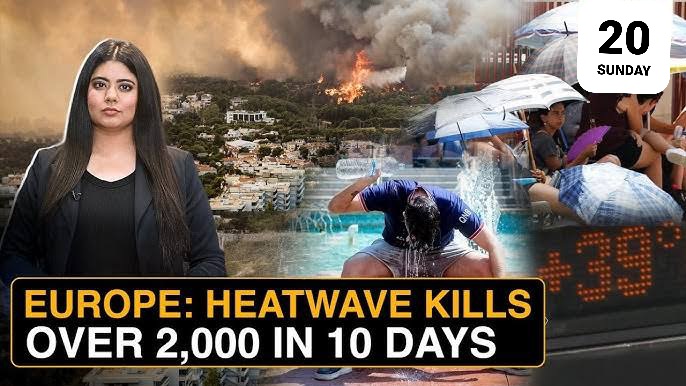
Historic heat wave in Europe will leave more than 2,300 dead by summer 2025
An unprecedented heat wave hit Europe between May and July 2025, leaving more than 2,300 dead in at least ten countries, according to a report published by Imperial College London. Extreme temperatures exceeded 45 degrees Celsius in regions such as Spain, Portugal, and France, triggering health crises, power outages, forest fires, and widespread climate change warnings.
Context of the heat wave in Europe 2025
The summer of 2025 has been classified as the hottest on record in Europe. The first heat waves began in late May, intensifying in June and reaching their peak during the first week of July. On July 2, Lisbon recorded a record high of 46.6°C, followed by Madrid with 44.3°C and Marseille with 43.7°C. In the United Kingdom, Birmingham reached 40°C for the first time since 2022. These figures triggered red alerts across almost the entire continent, including northern countries such as Germany, Belgium, and the Netherlands. Scientists agree that climate change has intensified the duration and frequency of heat waves. The accumulation of greenhouse gases, deforestation, and excessive urbanization are the main causes of this extreme phenomenon.
Human and health consequences
According to data from the European Centre for Disease Prevention and Control (ECDC), the number of heat-related deaths has exceeded 2,300 so far this summer. • In Spain, 1,180 deaths were recorded from heat exhaustion and respiratory complications. • In the United Kingdom, 570 deaths were directly linked to the heat wave. • In Portugal, the number has risen to 284 deaths. The most affected were older adults, children, and people with cardiovascular or respiratory diseases. Hospitals collapsed in regions such as Andalusia, southern France, and parts of Sicily, where intensive care units exceeded their usual capacity. The Italian Ministry of Health warned that 34% of hospitalized patients in July had symptoms resulting from prolonged heat exposure. In addition, cases of severe dehydration and acute kidney failure were reported.
Uncontrollable forest fires
Extreme heat fueled the development of more than 1,500 wildfires in Europe during June and July. The most affected areas were: • Portugal: Fires in the Leiria and Coimbra regions, with more than 15,000 hectares affected. • Spain: Active fires in Galicia, Castile and León, and Catalonia. More than 12,000 people were evacuated. • France: The Provence-Alpes-Côte d’Azur region suffered fires that devastated nature reserves. Firefighters across Europe joined forces through the EU civil protection mechanism. Greece, for example, sent brigades to Italy and Romania to combat simultaneous outbreaks.
Energy crisis and blackouts
The surge in electricity consumption for cooling caused grid collapses in countries such as Italy, Greece, and Romania. In cities such as Athens and Bucharest, blackouts of up to 12 hours were recorded. Electricity demand exceeded 130% of the seasonal average in some regions, forcing the implementation of rotating outages to avoid total collapse. Electricity companies have requested emergency subsidies from the EU to strengthen renewable energy infrastructure.
Economic impact
The 2025 heat wave also has serious economic consequences: • The agricultural sector has suffered losses in the millions: wheat, olive, and grape crops were devastated by the heat in Spain, Italy, and Greece. • Tourism, especially rural and nature-based tourism, registered a 45% drop due to cancellations and restrictions. • Transport companies in France and Germany reported damage to rail infrastructure due to steel expansion. The European Central Bank estimates that economic growth could slow to 0.6% quarterly if conditions persist until August.
Political and social reactions
The governments of France, Spain, and Portugal have declared a «regional climate emergency» and requested immediate financial support from the European Commission. In the European Parliament, several environmental NGOs proposed bringing forward climate targets to 2030, given the evidence of accelerated global warming. Measures being discussed include: • Extraordinary carbon taxes. • Tax incentives for green technologies. • A ban on the sale of combustion vehicles starting in 2028.
Mental health and vulnerable population
Mental health has also been affected. Heat isolation, the inability to work outdoors, and widespread fear have increased cases of anxiety, insomnia, and depression. In France, telephone psychological services reported a 37% increase in calls related to «heat stress.» In Germany, the government set up refrigerated community centers for older adults without access to air conditioning.
UN call and international measures
UN Secretary-General António Guterres issued an urgent statement on July 5, warning that «humanity is failing to curb climate change.» He called for an emergency summit in Geneva to coordinate global efforts. Some international proposals include: • Creation of a climate resilience fund for vulnerable countries. • Establishment of cross-border climate evacuation protocols. • Massive reforestation funded by G7 countries.
Scientific and future perspective
Experts from the Intergovernmental Panel on Climate Change (IPCC) have indicated that what Europe experienced this summer could become the norm if carbon emissions are not drastically reduced. The IPCC’s 6.0 predictive model projects summers with more than 30 days above 40°C by 2035 in southern Europe. Scientists also warn that climate change amplifies other risks: droughts, tropical diseases, food insecurity, and climate migration.
SUMMARY
La ola de calor que azotó Europa en 2025 no es un evento aislado, sino una consecuencia directa del deterioro ambiental global. Las pérdidas humanas, económicas y ecológicas nos recuerdan que el tiempo para actuar es ahora.
La unión entre ciencia, política y sociedad será clave para evitar que futuros veranos se cobren vidas y destruyan ecosistemas enteros. A menos que se tomen decisiones urgentes y vinculantes, el verano de 2025 podría convertirse en el primero de muchos episodios extremos e irreversibles en el continente europeo.
PUBLIC INFORMATION VIDEO